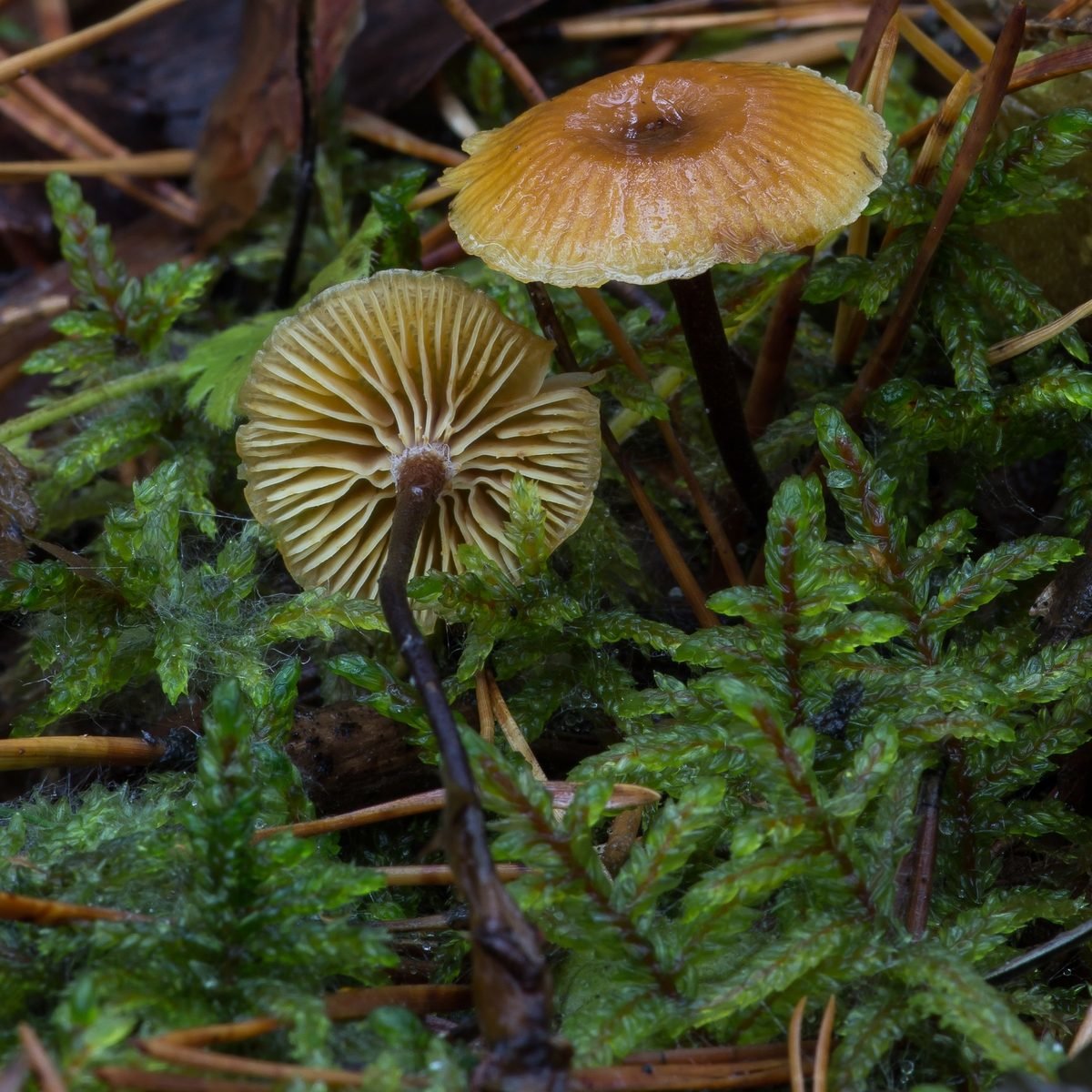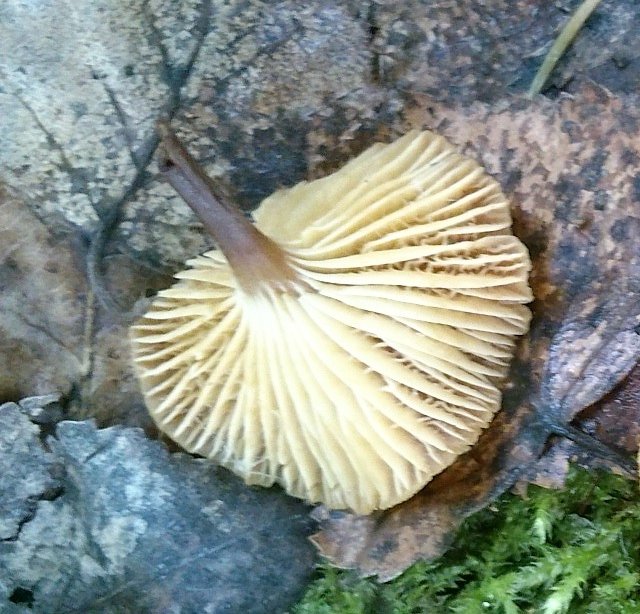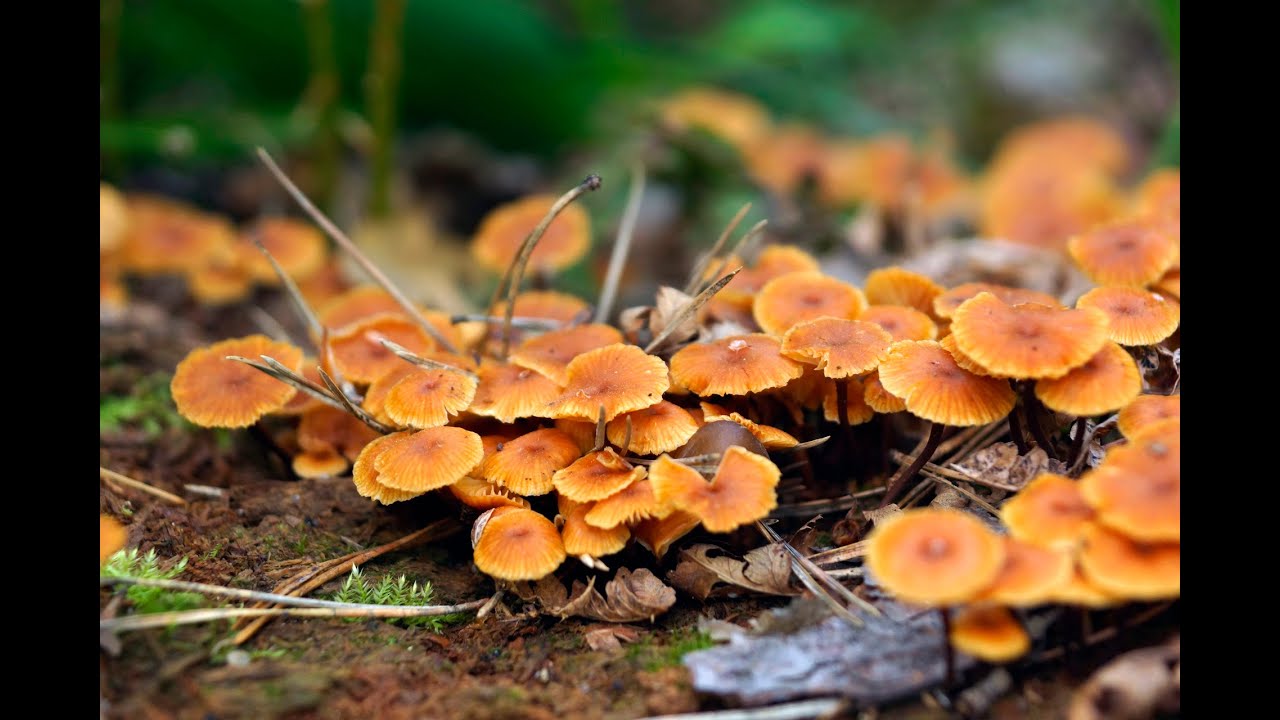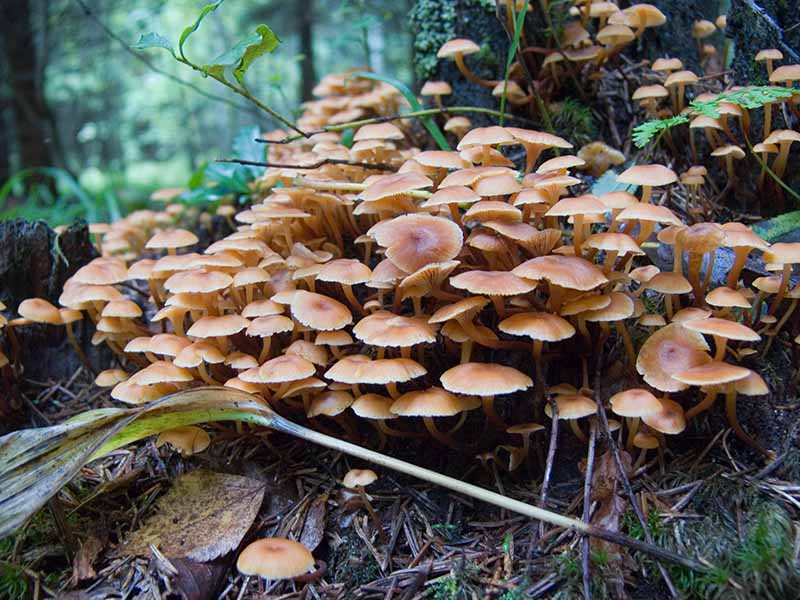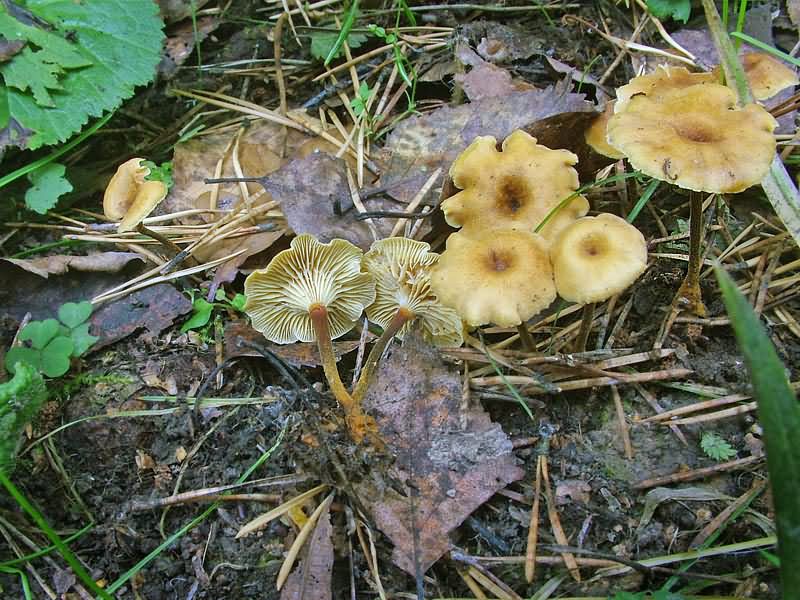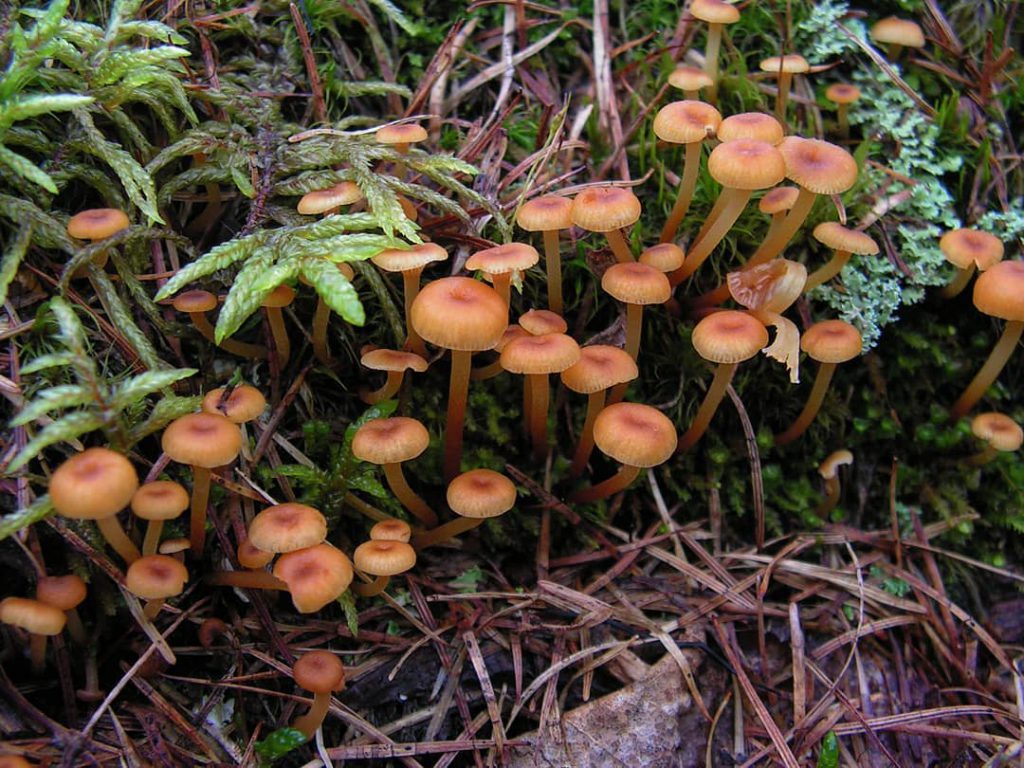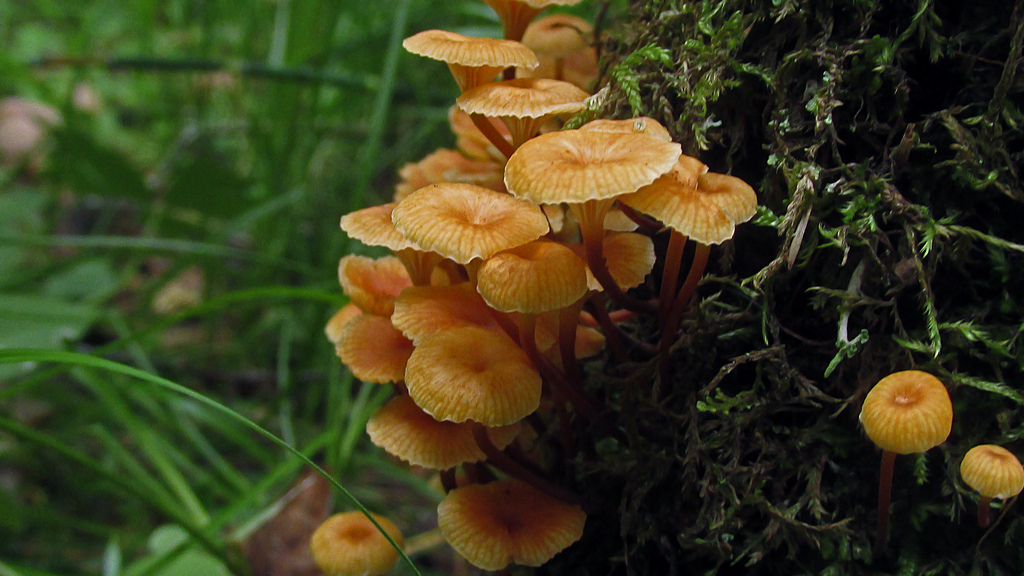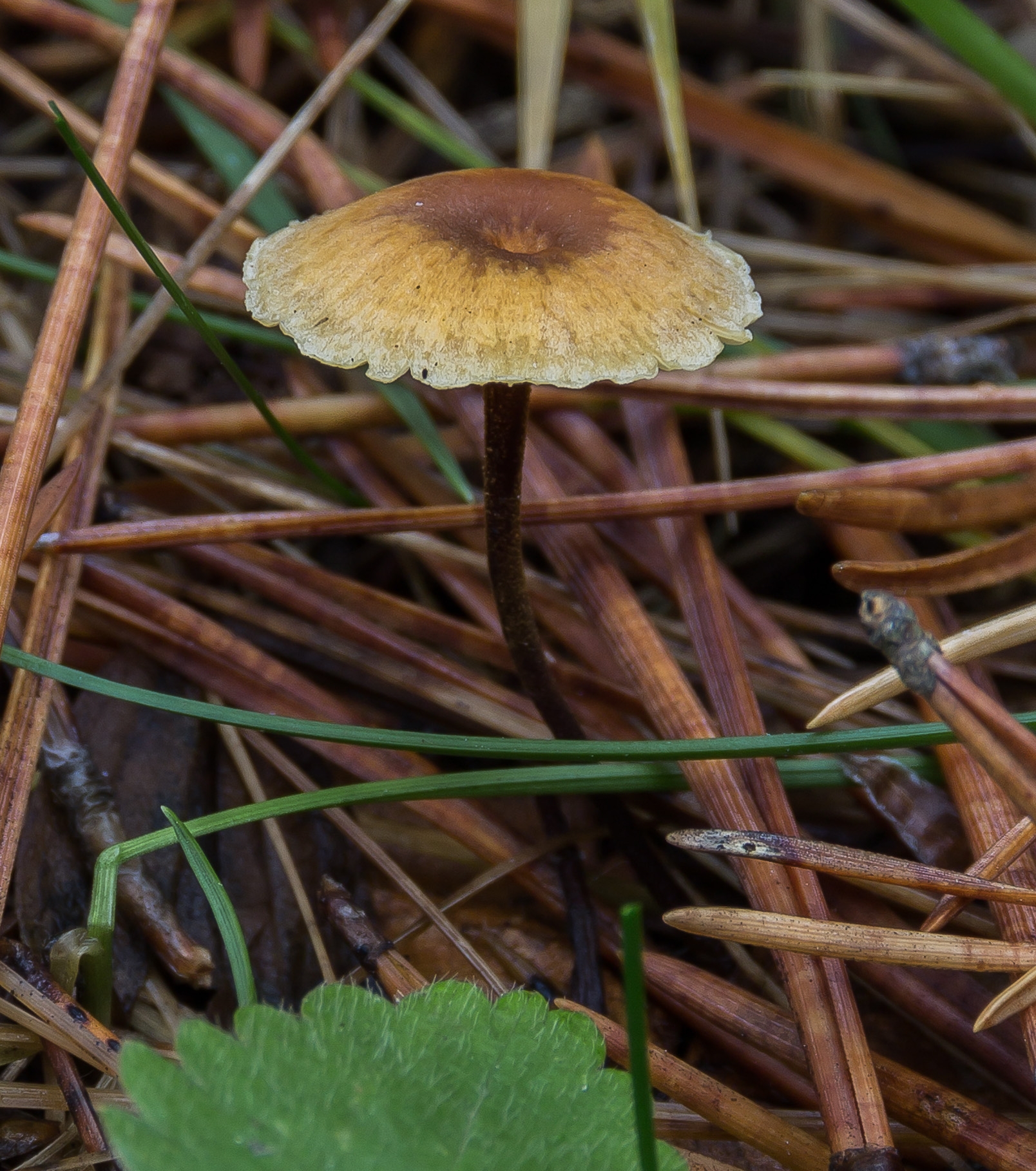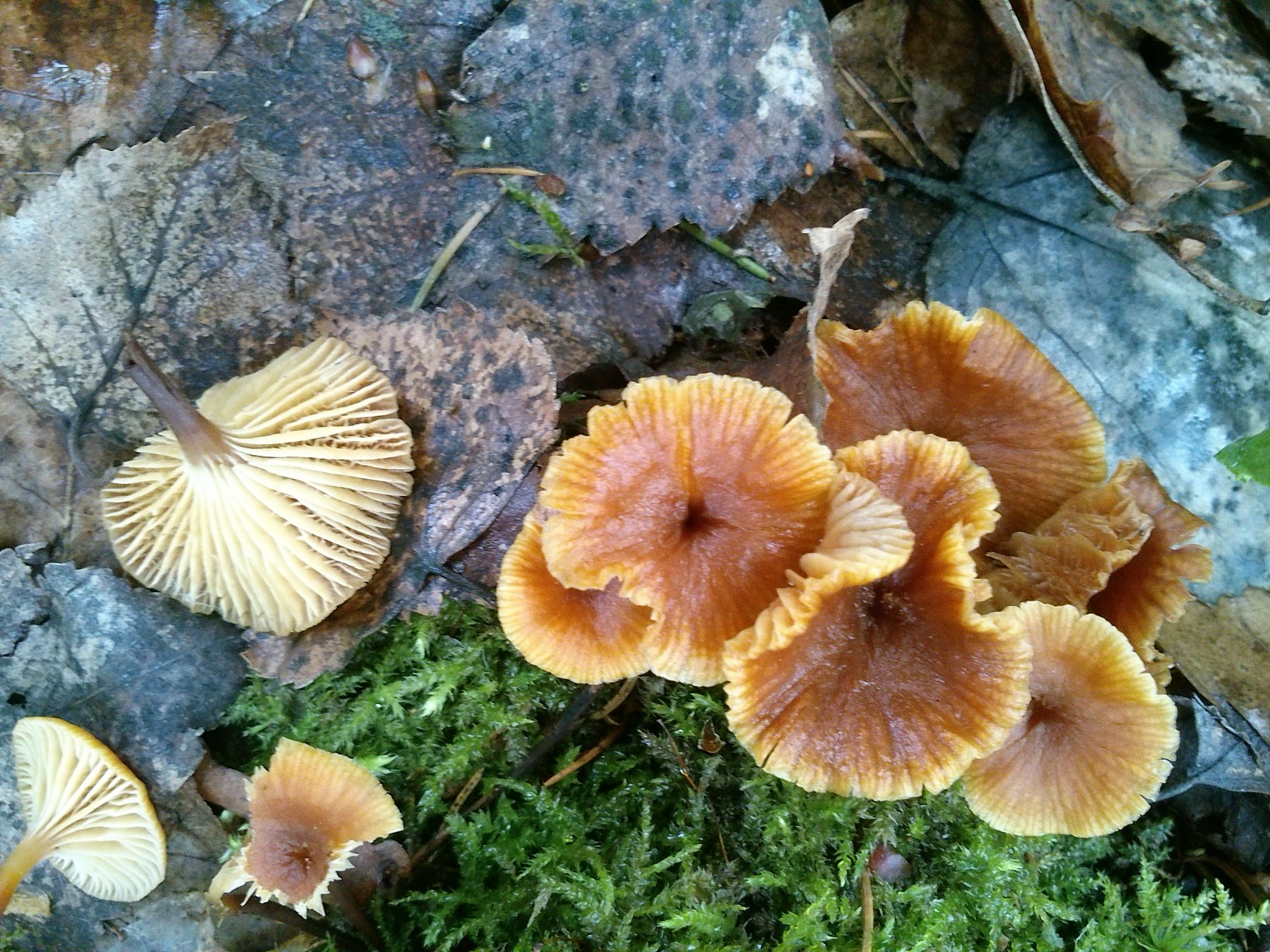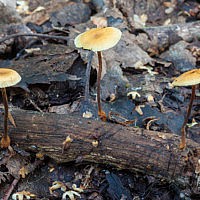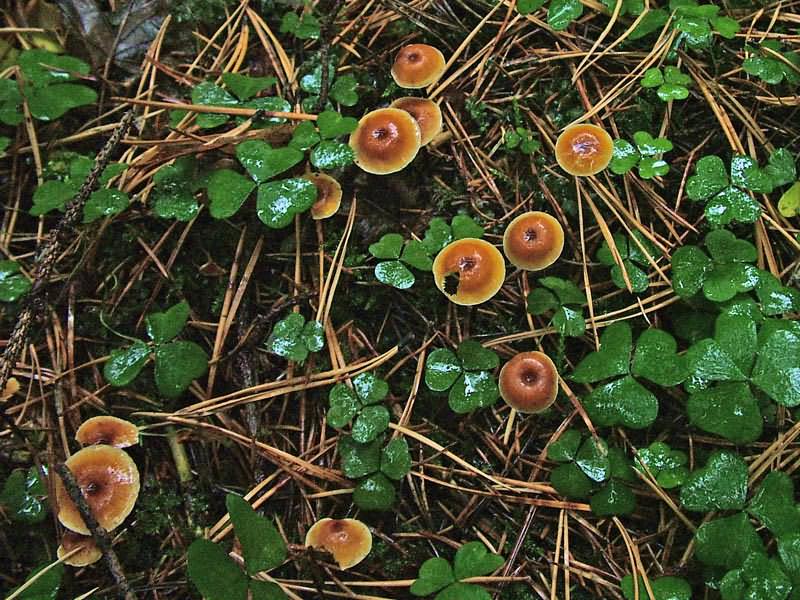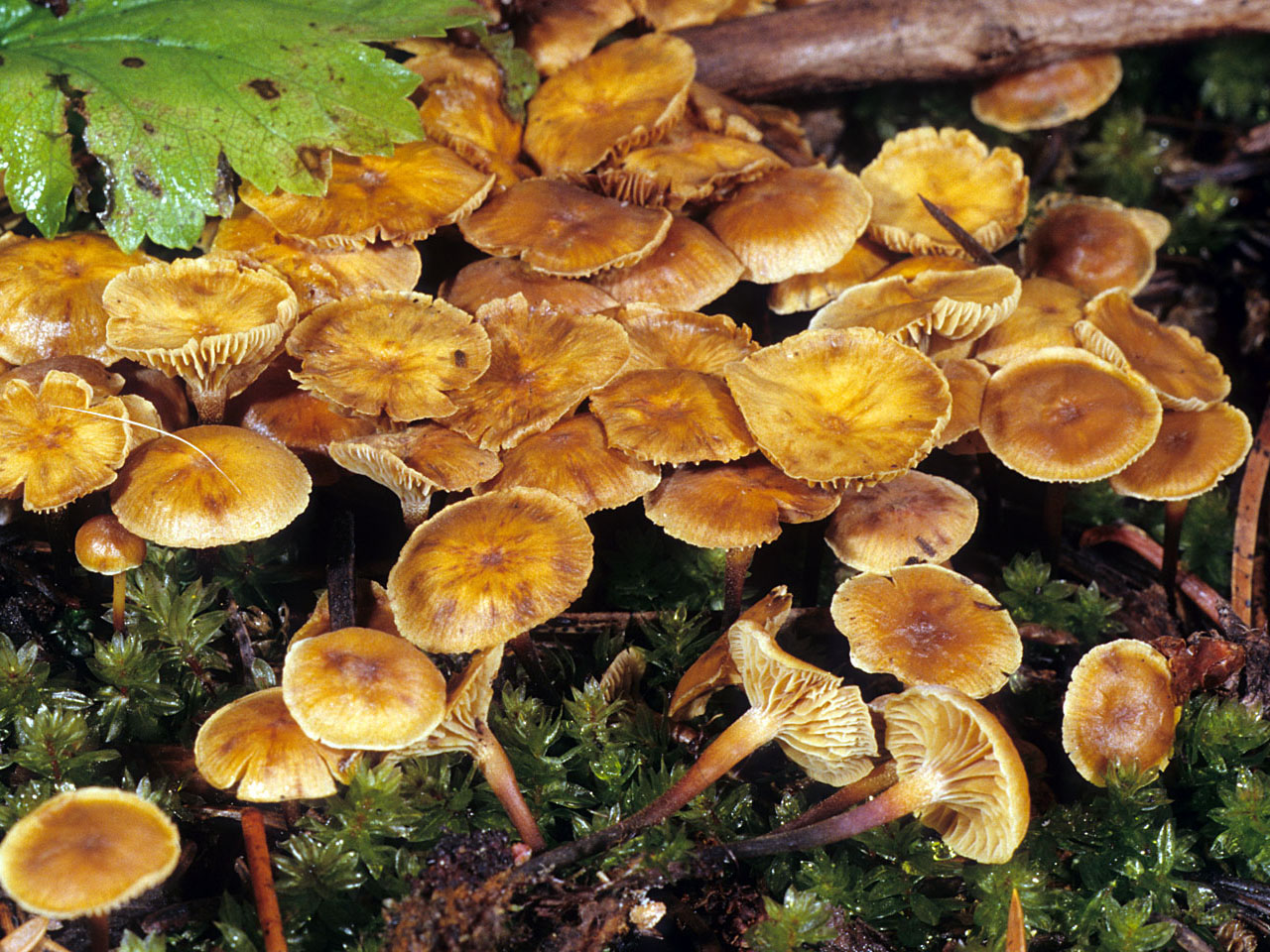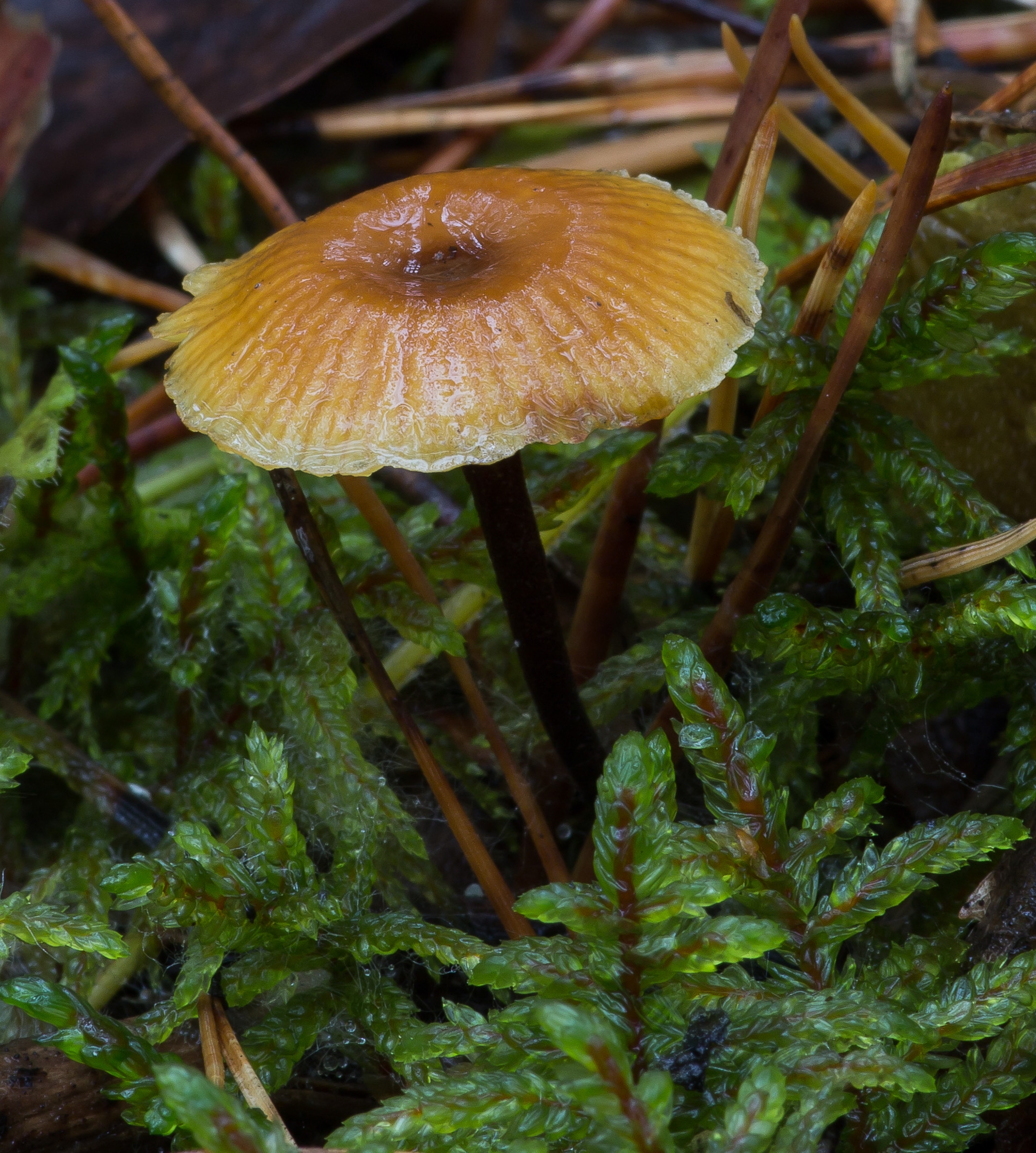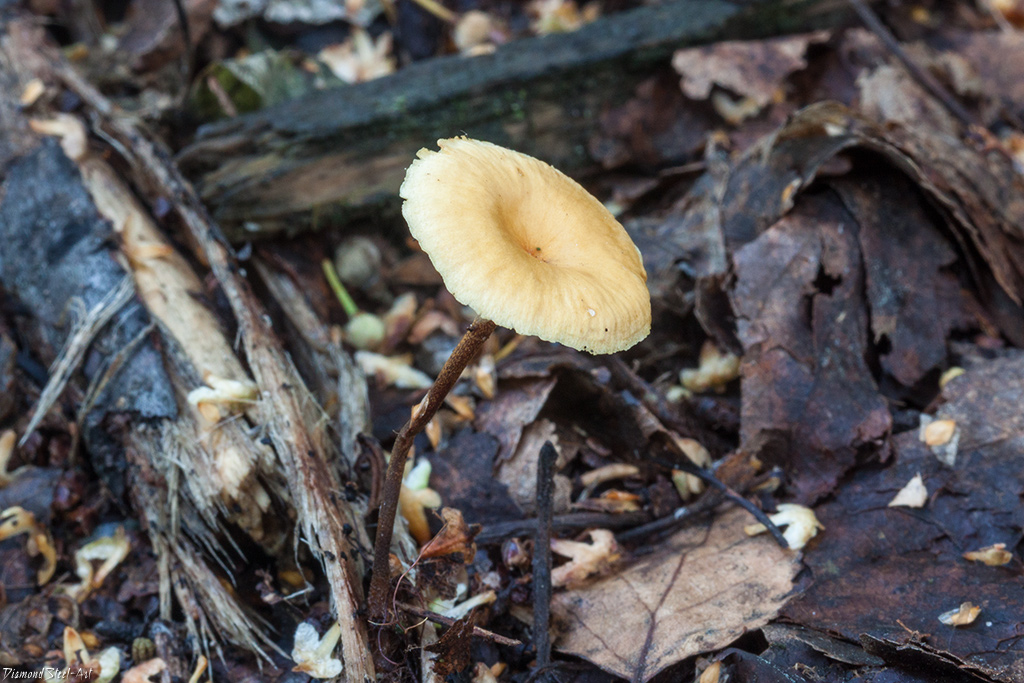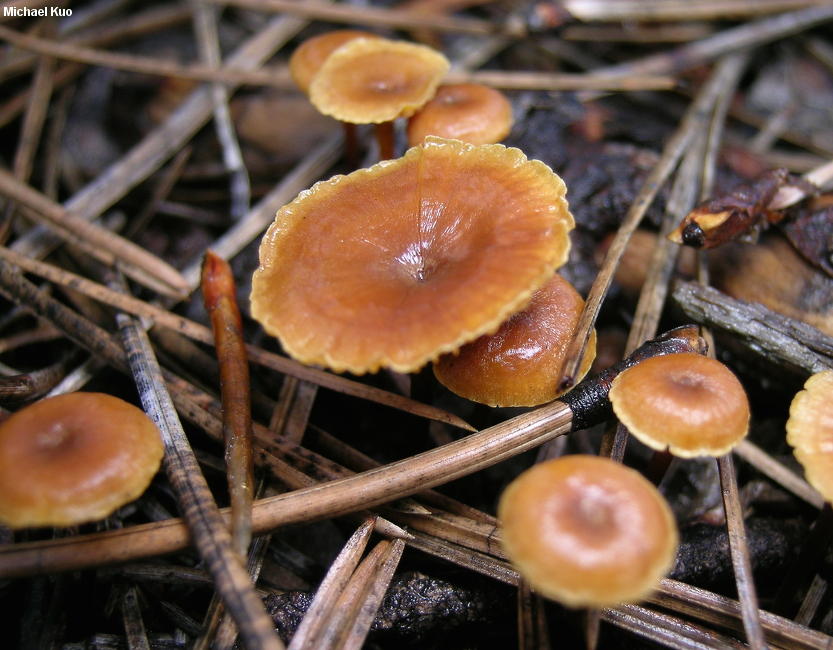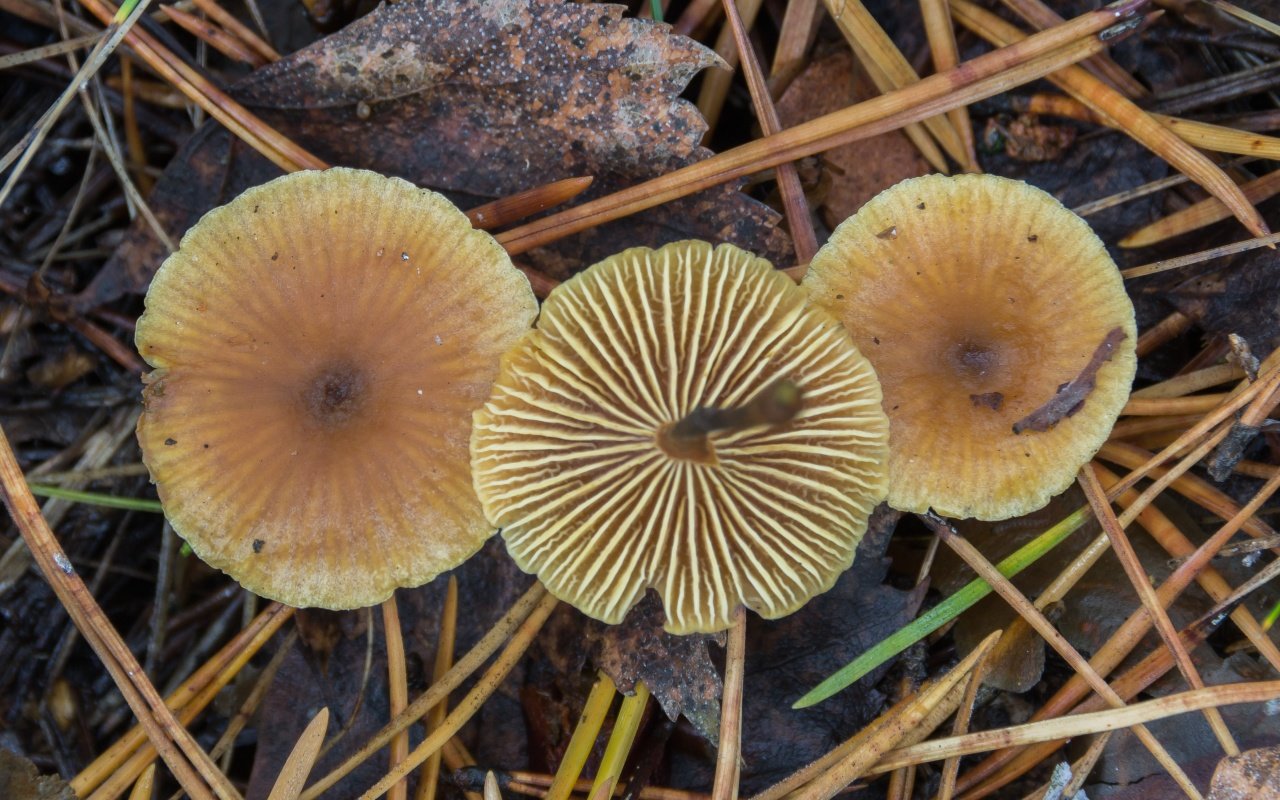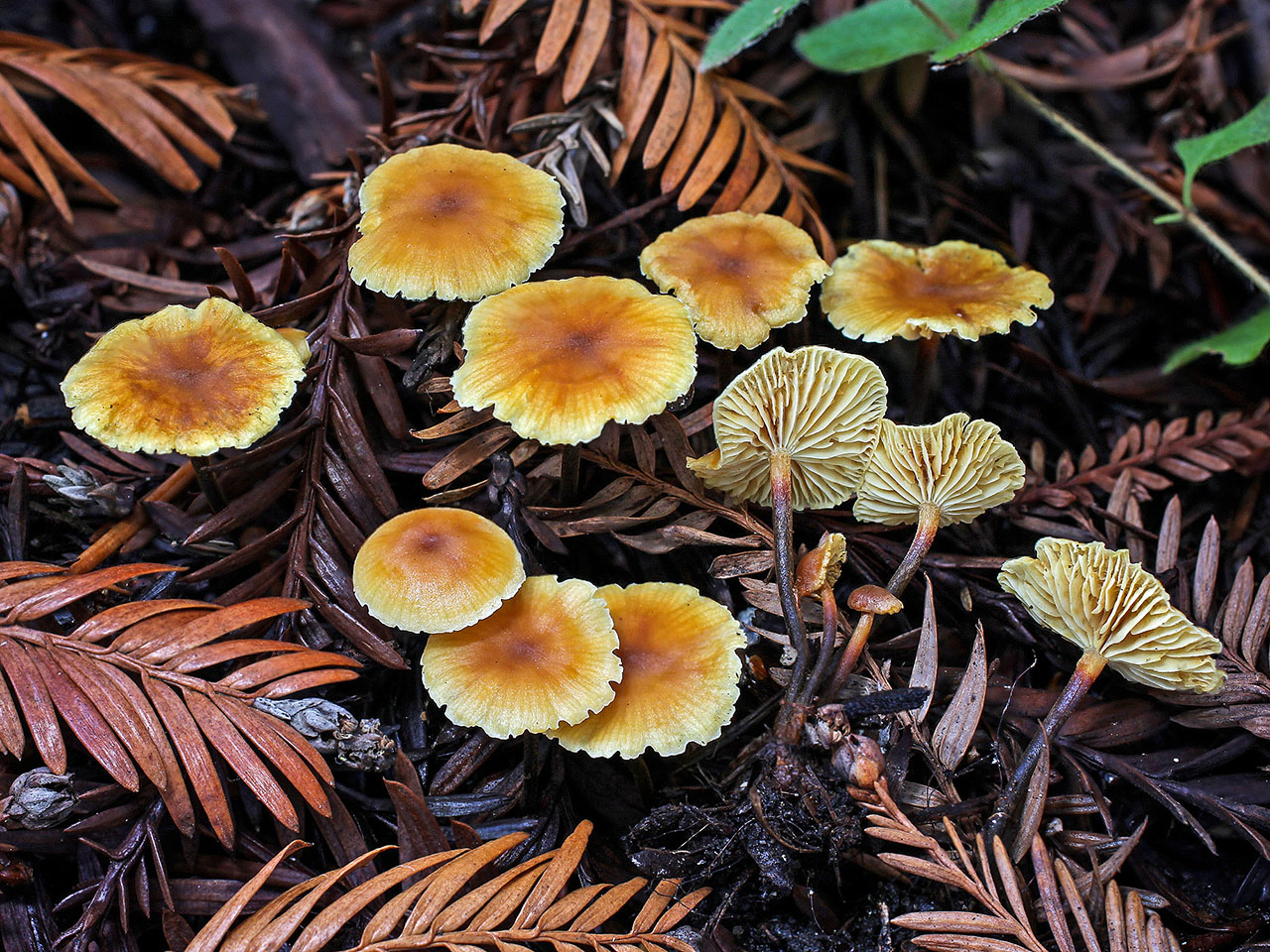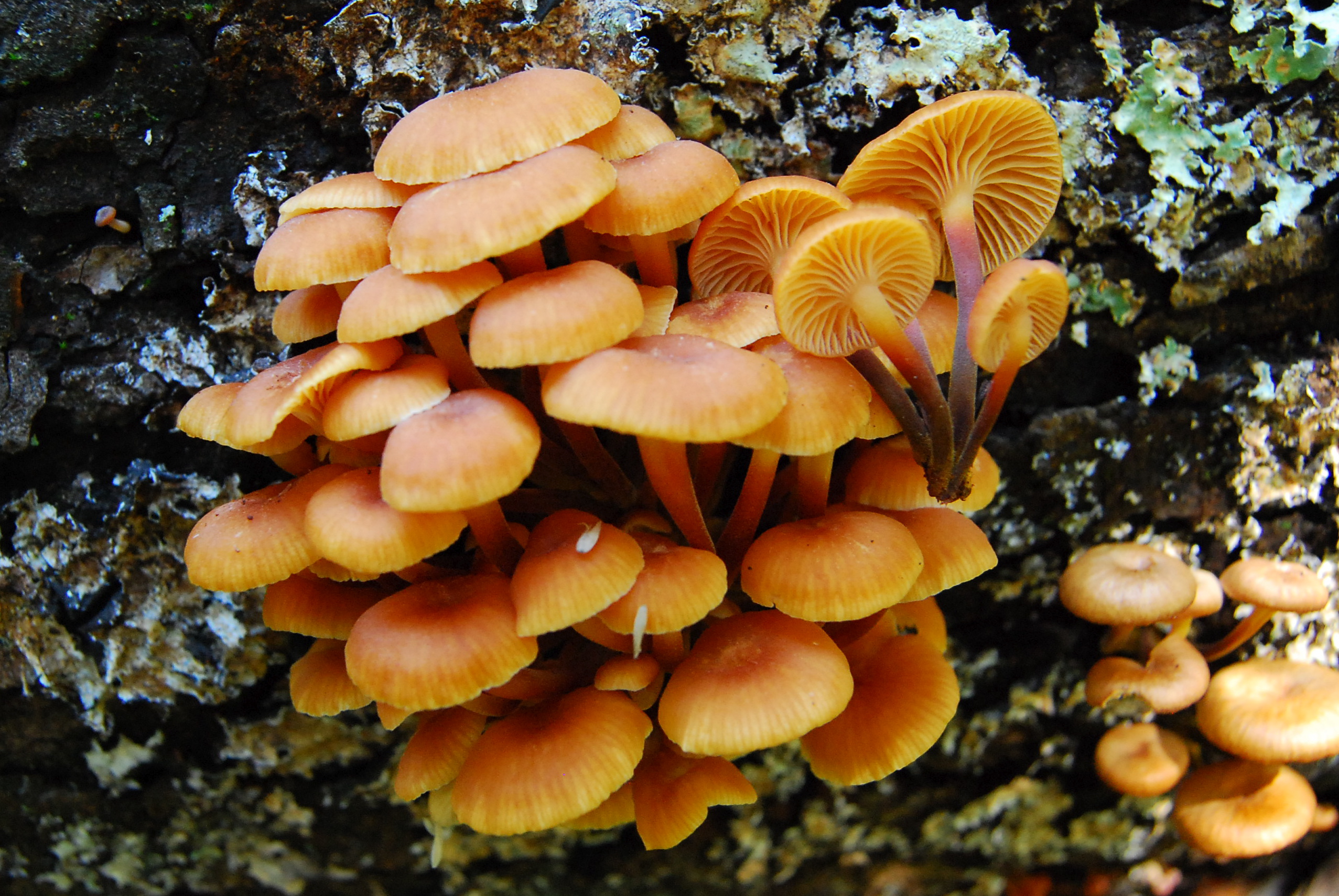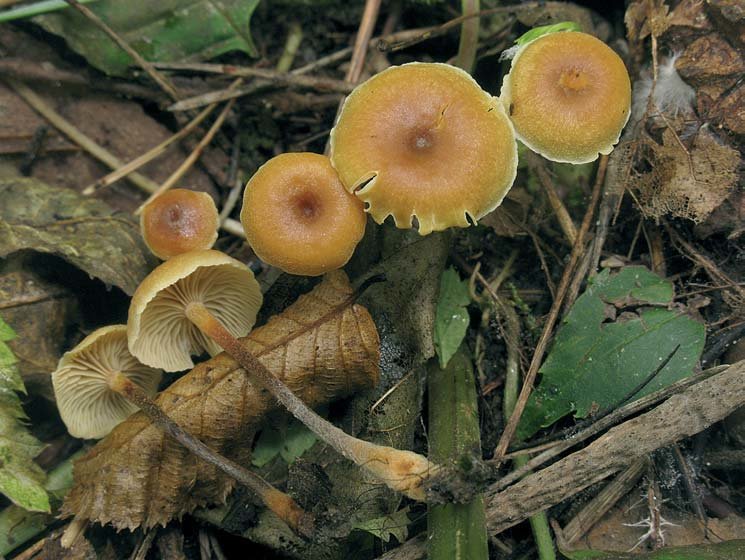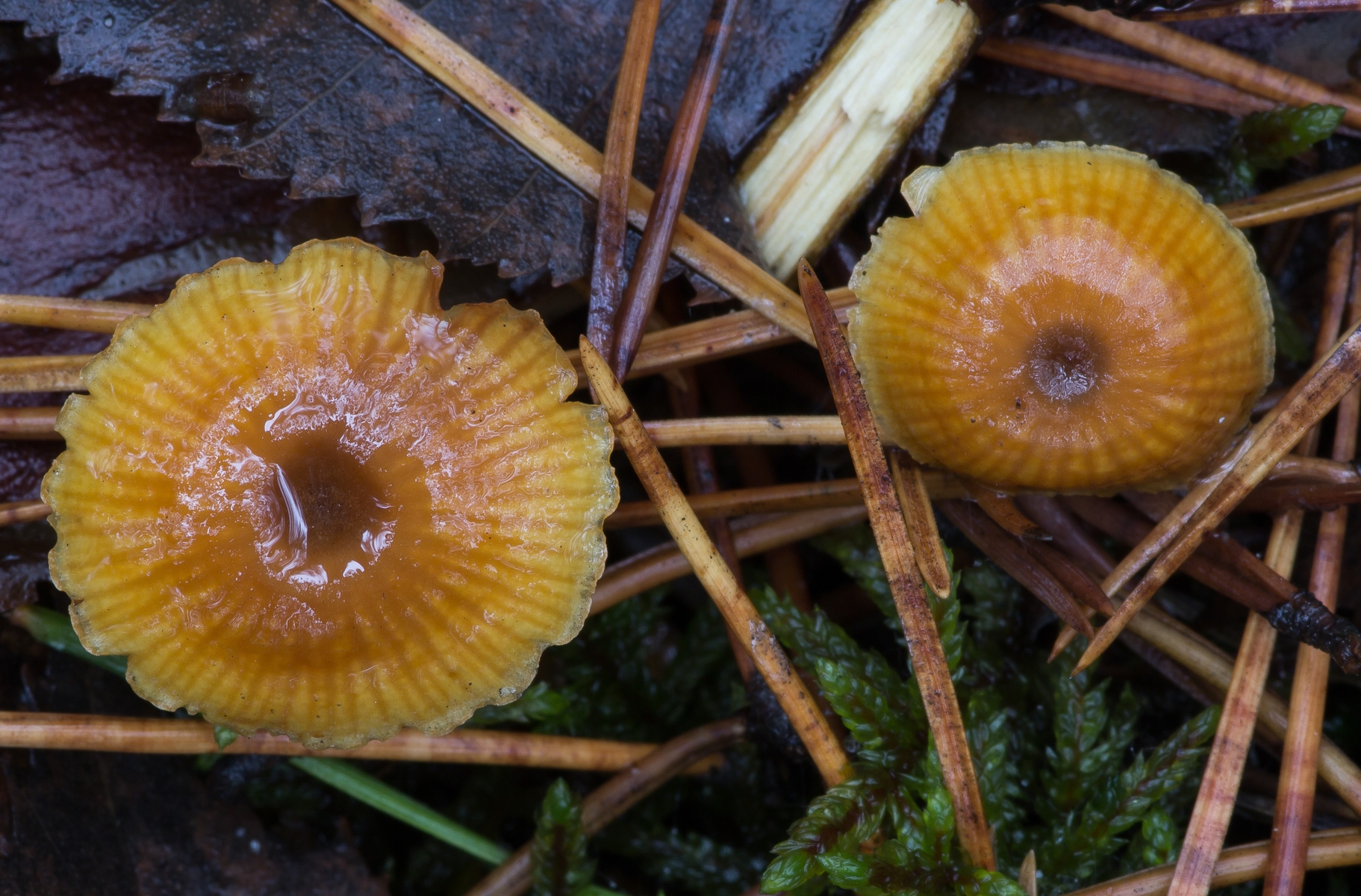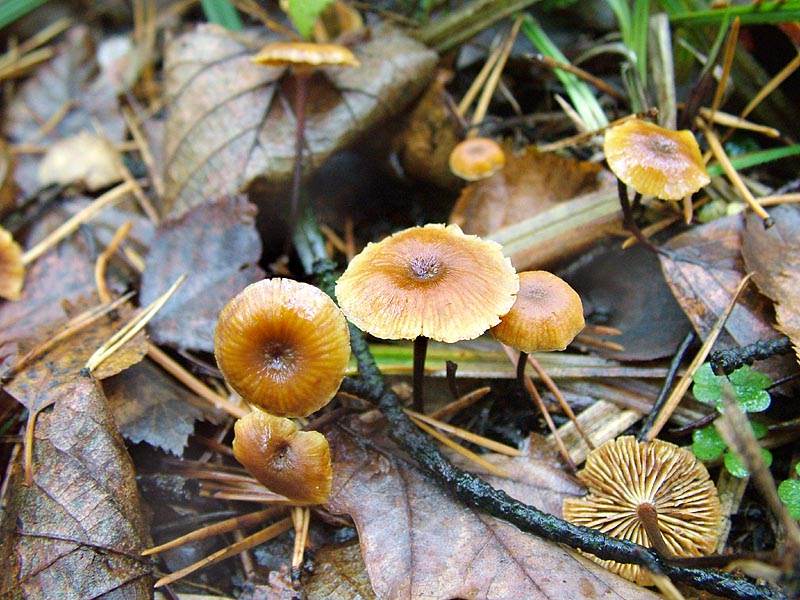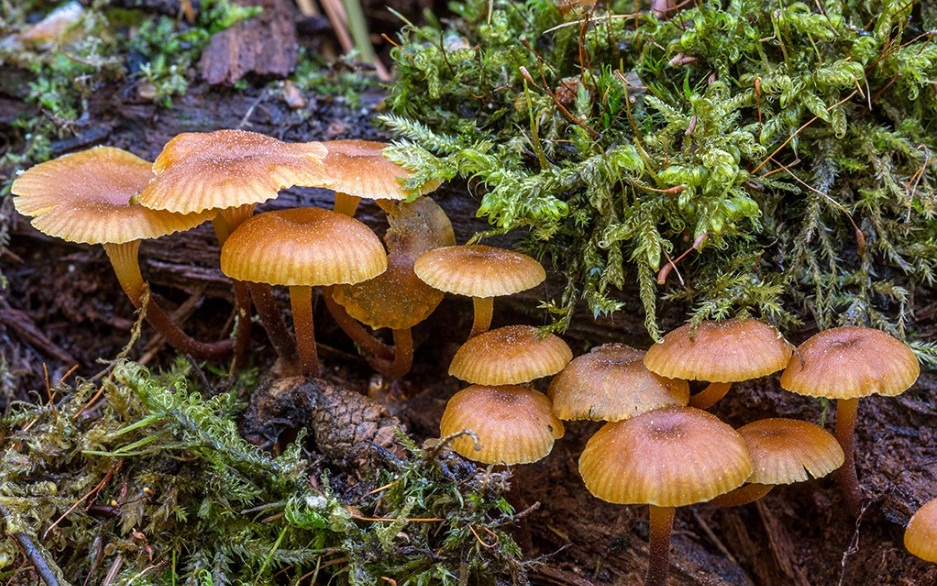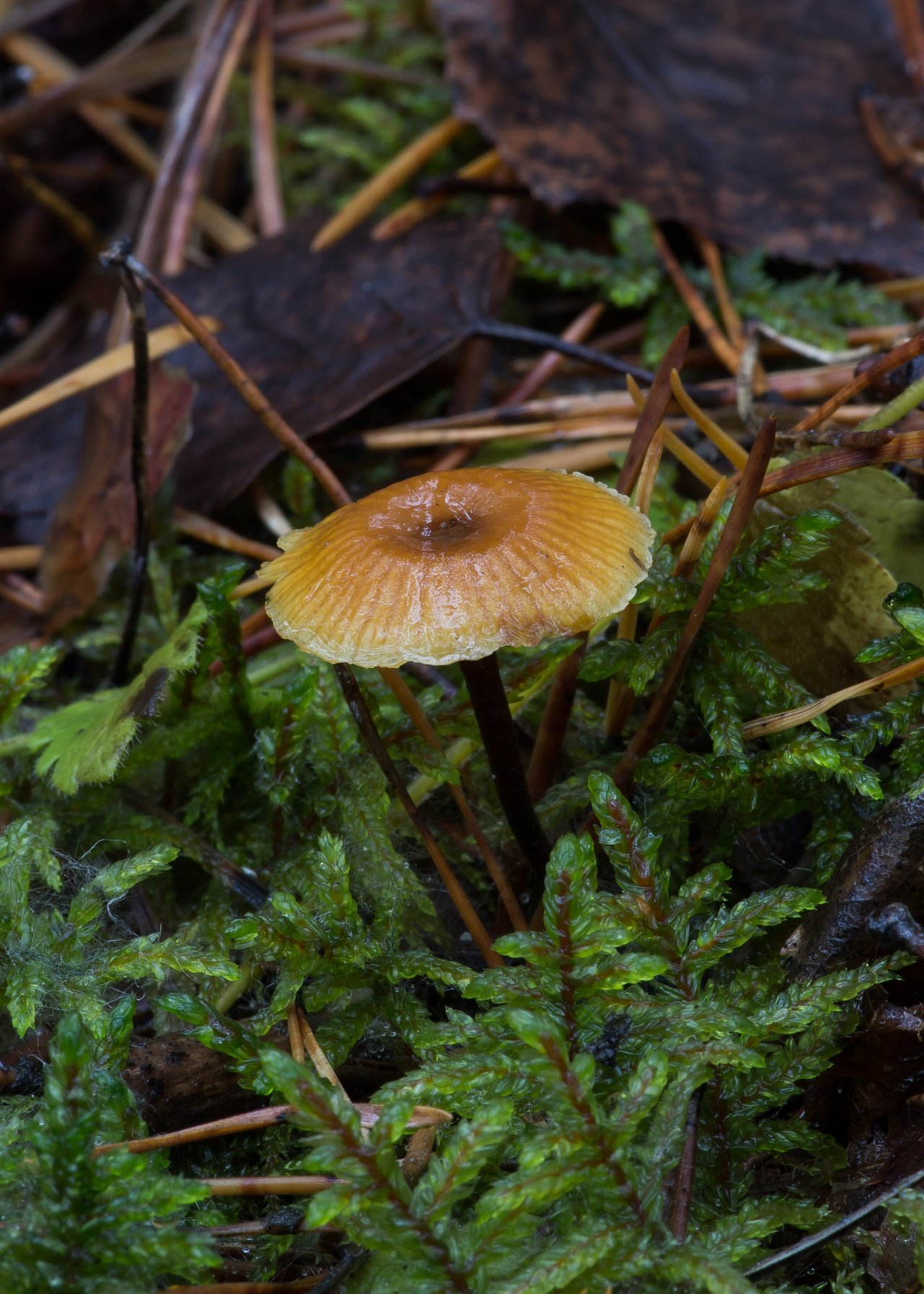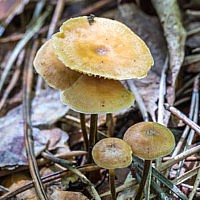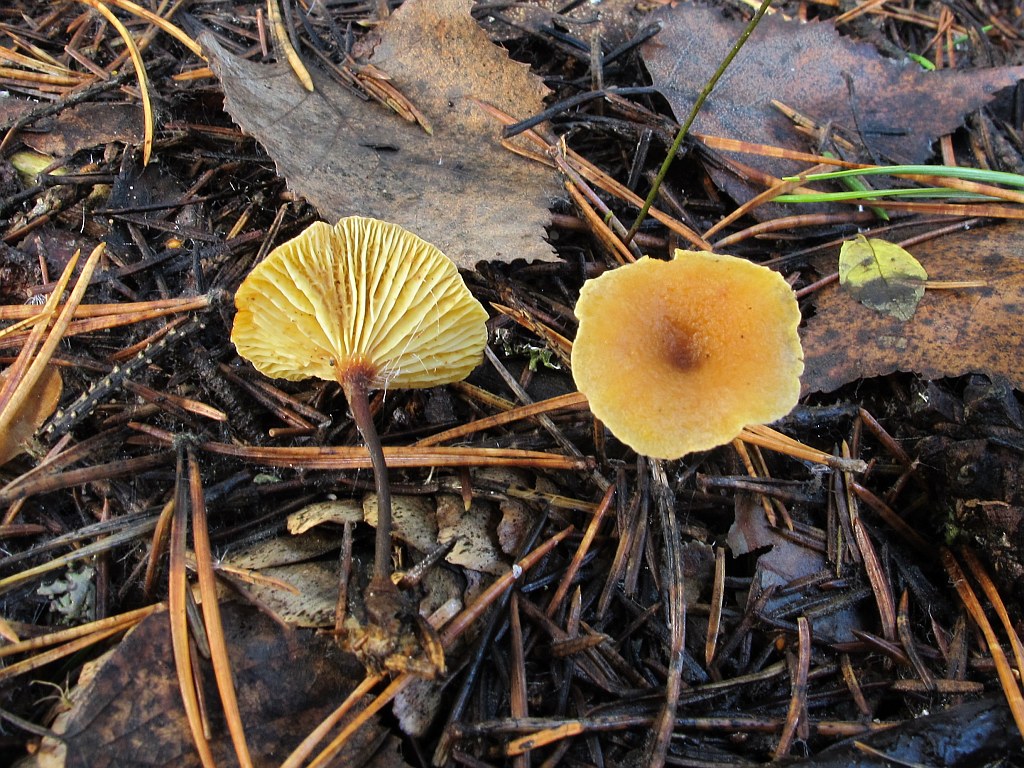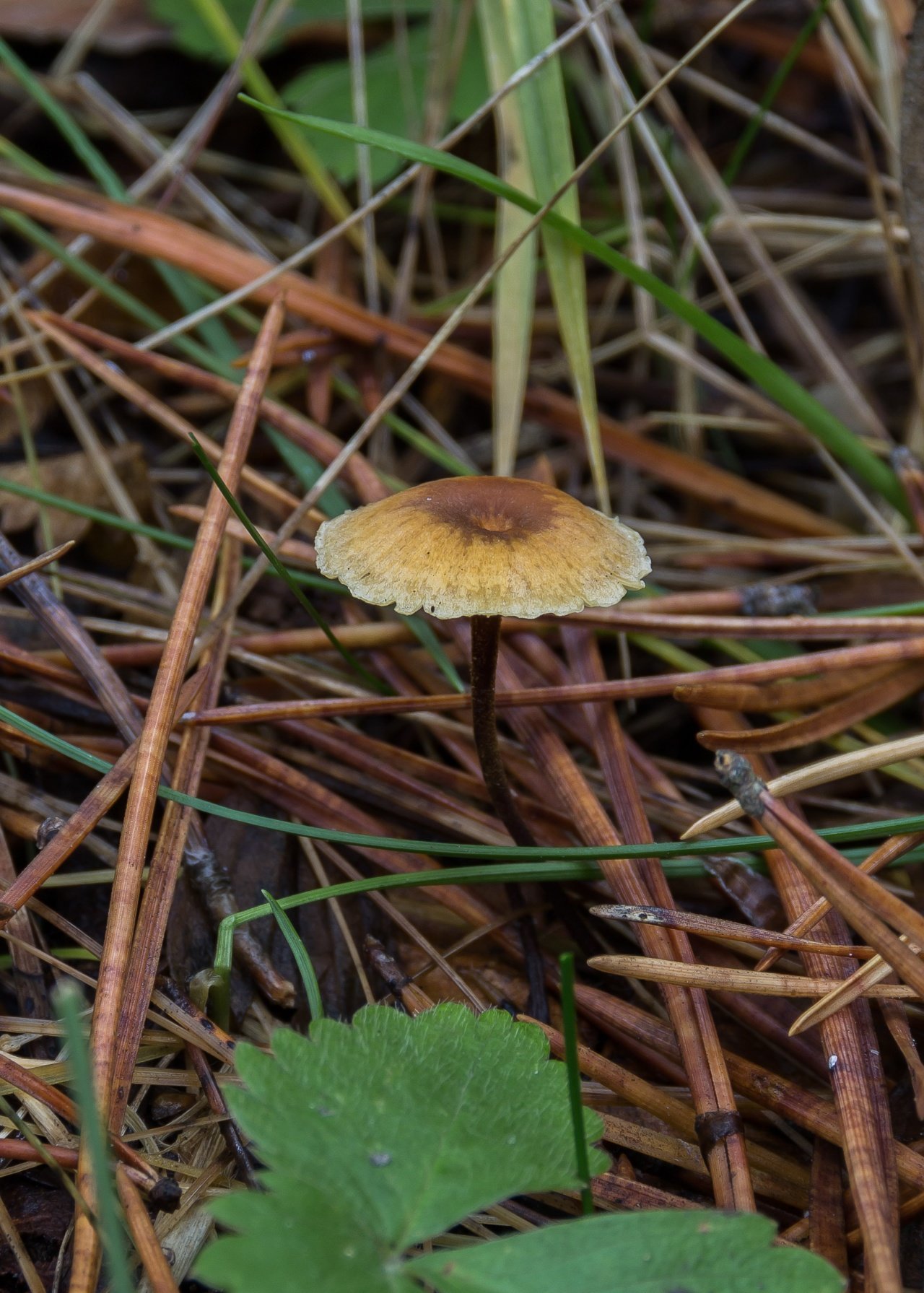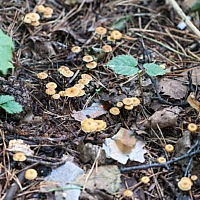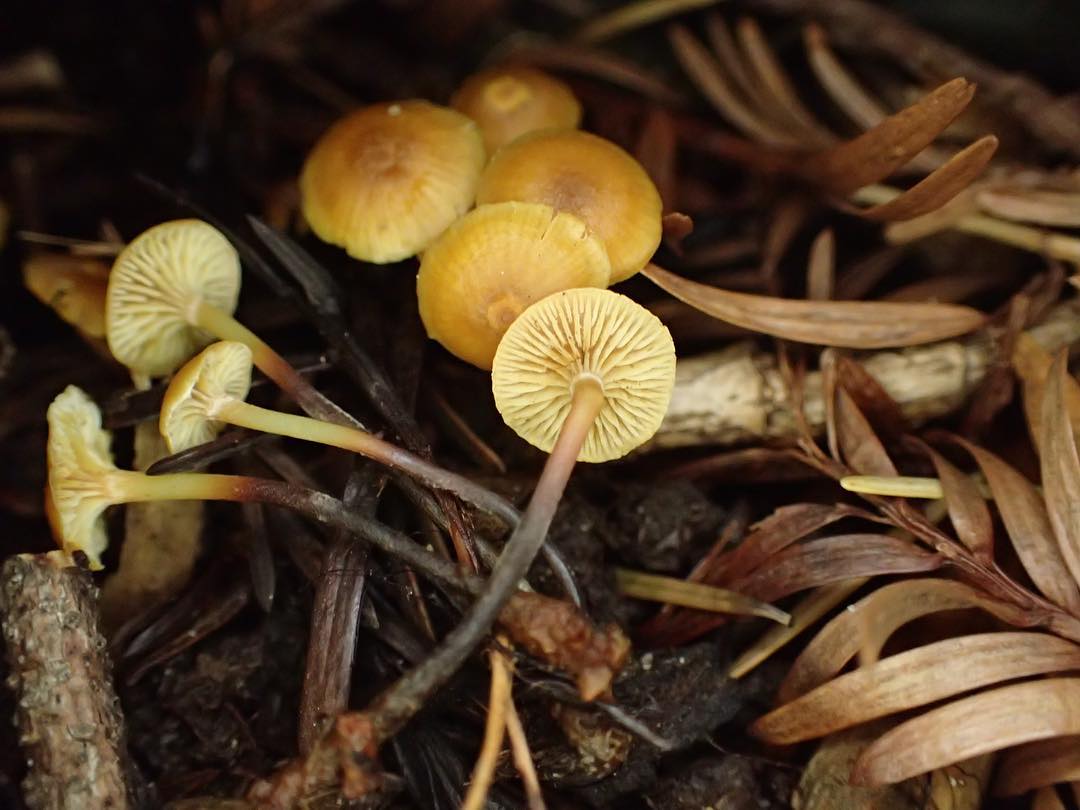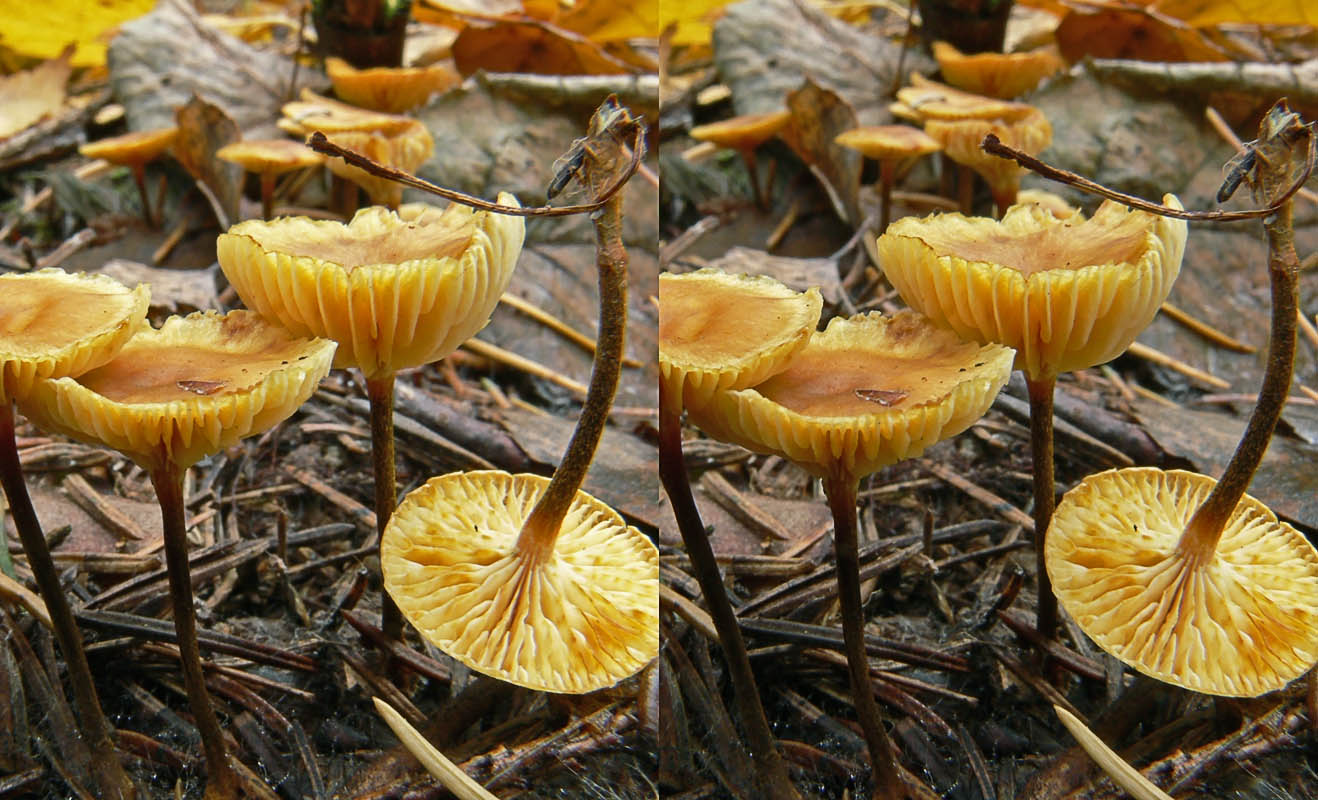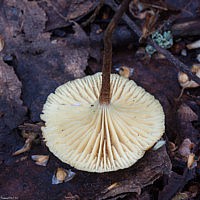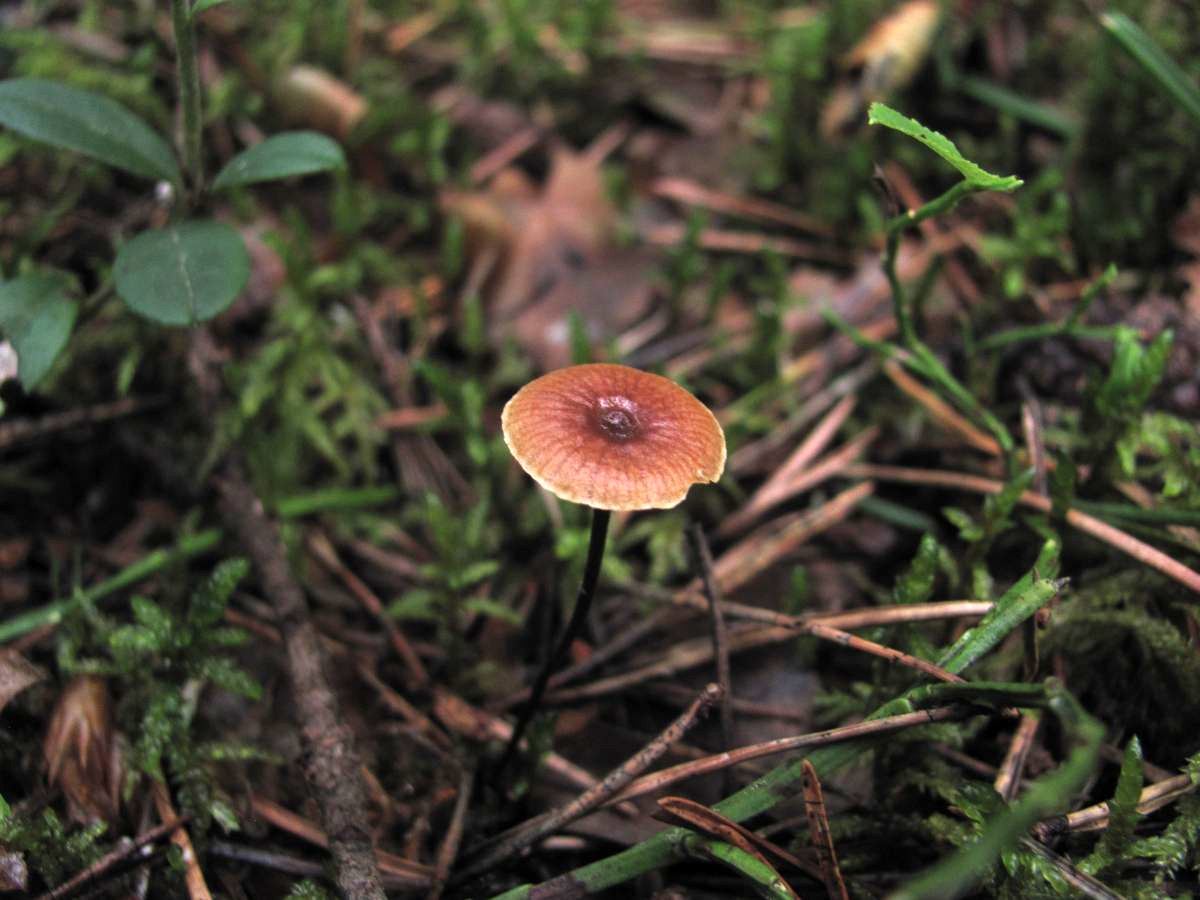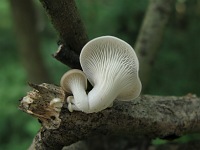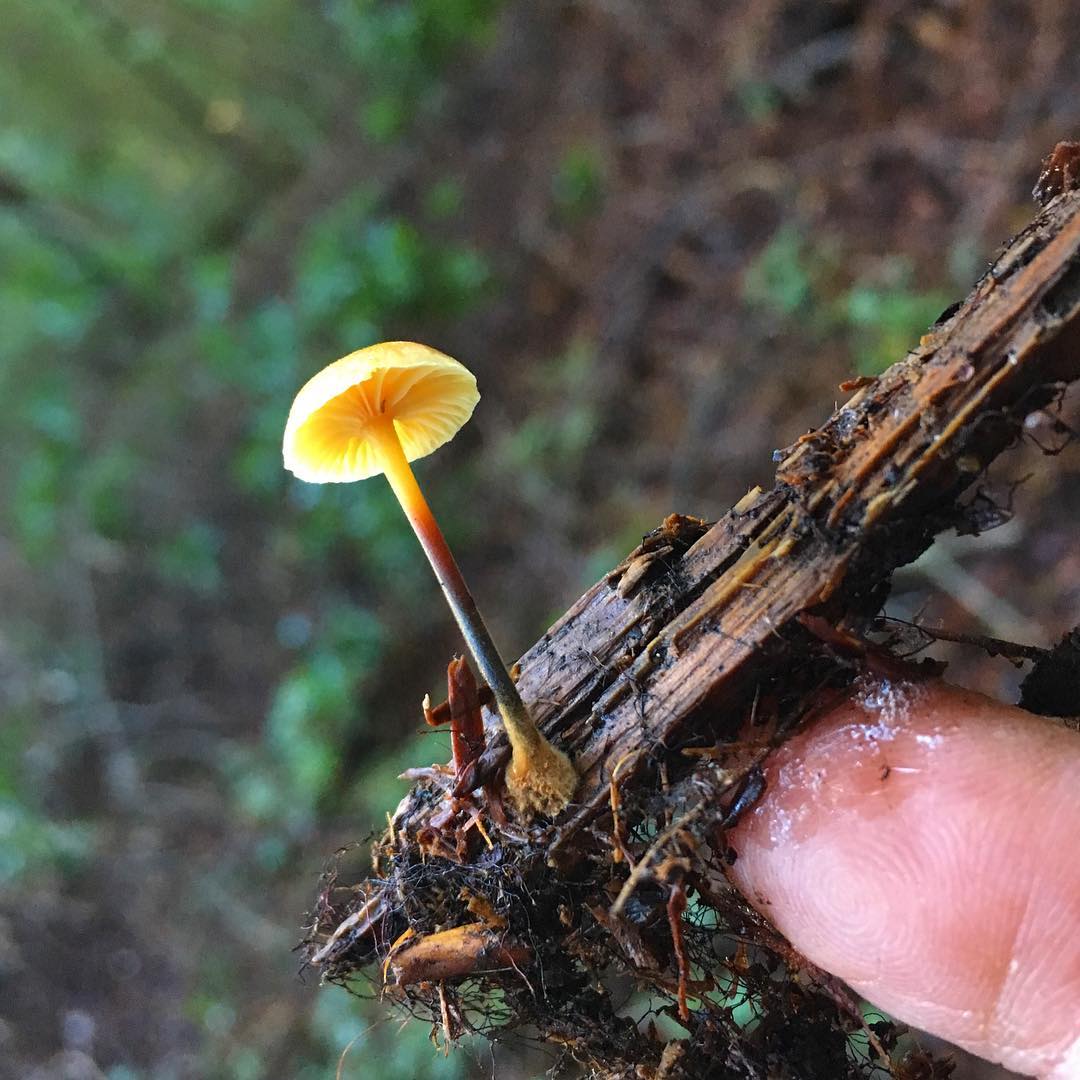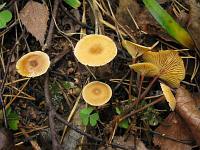What does a poisonous spiderweb mushroom look like (with photo)
Above, we looked at what the cobwebs look like, suitable for eating, and now it is the turn of the inedible species. It is worth knowing that the poisonous spiderweb mushroom is very dangerous, since it can be fatal.
See what a poisonous spider web looks like in the photo, remember it and under no circumstances pick it up in the forest:
Lazy webcap (Cortinarius bolaris)
Lazy webcap in the photo
Lazy webcap in the photo
The mushroom is inedible. Caps up to 3-8 cm, at first hemispherical, then convex and finally open, clay-yellow, densely covered with large red or red-orange scales. In young mushrooms, the scales are glued to the surface of the cap, the yellow color of the surface is visible only as small gaps between the red scales. In mature mushrooms, the scales diverge along the surface of the cap and lag behind it at the edge. The plates are clay-yellow, then brown, turn red when damaged. Leg 5-7 cm long, 5-15 mm thick, cylindrical, reddish-fibrous, often scaly, like a cap. The pulp is whitish with a brownish tinge. Spore powder yellow-green.
Grows in deciduous, mixed and coniferous forests on acidic soil.
Fruiting from August to September.
It has no poisonous counterparts.
Goat webcap (Cortinarius traganus)
The goat webcap grows very abundantly in deciduous and coniferous forests
Goat webcap in the photo
The mushroom is inedible. Massive caps 3–12 cm, at first, spherical and lilac, then hemispherical and, finally, open ocher, with a fringed edge. The plates are buffy-yellow with a violet tinge, later brownish-ocher. The leg is lilac or yellow, with scales, 5-10 cm long, 2-3 cm wide, with an extension at the bottom. The pulp of young mushrooms is white-blue, then ocher with an unpleasant "goat" smell of acetylene.
Fruiting from August to October.
The goat spider web has no poisonous counterparts.
The goat webcap is inedible due to the unpleasant smell of acetylene.
Common webcap (Cortinarius triviah)
Common webcap in the photo
Common webcap in the photo
The edibility of the mushroom is questionable. Caps up to 5-8 cm, at first hemispherical, then convex or open, mucous yellow-rusty-brown, dry straw-yellow Plates are white-gray with a violet tinge, later rusty-brown. Leg yellow or bluish, 8-12 cm long, 1-2 cm wide, covered with mucus in the upper part, with dark belts in the lower part. The pulp is light, whitish-buffy, in old mushrooms with a weak unpleasant odor.
Fruiting from July to September in large quantities.
It looks like an inedible slimy spider web (Cortinarius mucosus) with a white leg.
The common webcap is not designated as a poisonous mushroom, but its edibility is in doubt.
Description of xeromphalin campaniform
The cap of this mushroom is miniature - 0.5-2 centimeters in diameter. The shape of the cap is bell-shaped; there is a specific hole in the middle. The color of the cap is yellow-brown.
The flesh of the mushroom is thin, without a special smell. The color of the pulp is the same as that of the cap. The plates descend along the leg, they are located infrequently. The color of the plates matches the color of the cap. A special feature of xeromphaline bell-shaped are veins, which are arranged alternately and connect the plates to each other. Spore white powder.

The leg is fibrous, flexible. It is very thin, only 1 centimeter thick. The upper color of the leg is light, and the lower one is much darker - brown.
Places of distribution of xeromphalin campaniform
These mushrooms often grow in spruce glades. Xeromphaline bell-shaped bears fruit from May to autumn. Most often they come across in the spring.The first mushroom wave is the most abundant.

The similarity of xeromphaline bell-shaped with other mushrooms
If you do not consider in detail the bell-shaped xeromphaline, then it can be confused with the scattered dung beetle. These mushrooms grow in the same places.
In addition, bell-shaped xeromphalins are similar in shape to numerous omphalins, but the latter are most often found on the soil. In addition, omphaline does not have the characteristic transverse veins connecting the plates to each other.

Other mushrooms of this genus
Xeromphaline Kaufman is an inedible mushroom. The fruit body is small, and the cap of the mushroom is thin-fleshy. The largest specimens have caps up to 2 centimeters in diameter. The leg is thin, bizarrely curving. The color of the fruiting body is light brown.
Kaufman's xeromphaline grows on rotting stumps. Found in deciduous forests and spruce forests. They settle in colonies. These mushrooms are especially numerous in spring.

Xeromphaline stem-shaped is an inedible mushroom. His hat is miniature - no more than 1.5-2 centimeters in diameter. There is a notch in the center of the cap. The edges of the cap are lowered. Its color is yellow-ocher, yellow-gray or ocher-brown. The pulp does not have a special taste, and its smell is weak and rare. The leg is 3-4 centimeters high. Its shape is cylindrical, inside it is hollow. The coloring of the leg is yellow-brown.
Xeromphaline stem-shaped is a rare species. These mushrooms grow in North America, Western Europe and East Asia. They bear fruit throughout the summer. They grow on the remains of wood, they can also settle on moss. Meet in small groups

Fern Eagle
One of the most famous and widespread Ferns on the planet is the Orlyak fern - a beautiful bright plant, it can decorate any corner in the garden, forest or near a pond.
The culture is used in folk medicine - a decoction from the shoots is used to relieve stress, remove radionuclides, eliminate fever, and strengthen the skeleton. The decoction of the roots has an anthelmintic effect, relieves joint aches, and helps with diarrhea.
The main characteristics of the culture:
What does the bracken fern look like? Common bracken is a perennial herb of the Dennstedtiye family. A distinctive feature when describing a fern is frond, shaped like the wings of an eagle with tips curled inward. Usually Orlyak reaches 70 cm in height, but in more favorable climatic conditions (Primorsky Krai) it grows above a meter. The root system is well developed, deeply located, due to which the plant grows quickly, adapts to any climatic features - the roots do not freeze, they are not afraid of drought, rainfall and even fires.
Where does the bracken fern grow? The culture is found in all corners of the globe, except for Antarctica and the desert, and is widespread in Russia: in the middle zone, in Siberia, the Urals, the Far East, and the Primorsky Territory. Habitat - coniferous (pine) and deciduous (birch) forests, as well as edges, hills, water bodies. It grows well on pastures, clearings, abandoned fields. Prefers sandy, light soil, limestone. In some countries, the fern multiplies at such a fast rate that it is fought like a weed.
How to grow Orlyak at home? Fern is a beautiful original plant that can decorate a corner in the house or an alpine slide in the garden. It is unpretentious, adapted to different climatic conditions, undemanding in maintenance. Bracken is able to reproduce by dividing the bush, spores, rhizomes, processes. Spore reproduction is a long and painstaking process, which is rather difficult to implement at home. The best way to grow a crop is to use a dividing bush or plant shoots by the root. In this case, you need to carefully examine what the fern looks like: stem, leaves, root system. They must be resilient, free from stains and damage.
To plant Orlyak in a pot, it is necessary to prepare a sandy substrate, lay out drainage from gravel or bricks on the bottom. The plant is transplanted into the garden in the spring in a shaded place, protected from drafts. Sand, some ash should be added to the soil, small pebbles should be placed on the bottom.
Note! Fern loves moisture, so it needs regular watering and spraying. When pests appear (scale insects, whiteflies, thrips), insecticides are used
It is not worth trimming the crown - the old pagons are replaced with new ones in the spring.
When pests appear (scale insects, whiteflies, thrips), insecticides are used. It is not worth trimming the crown - the old pagons are replaced with new ones in the spring.
Xeromphaline bell-shaped: description and photo
| Name: | Xeromphaline bell-shaped |
| Latin name: | Xeromphalina campanella |
| Type of: | Inedible |
| Synonyms: | Omphalina bell-shaped, Omphalina campanella |
| Specifications: |
|
| Systematics: |
|
Xeromphalina campanella or omphalina campanulate is a mushroom that belongs to the numerous genus Xeromphalina, the Mycene family. It has a hymenophore with rudimentary plates.
What do bell-shaped xeromphalins look like?
This mushroom is very small. The size of its cap is similar to 1–2 kopeck coins, and does not exceed 2 cm in diameter. The color of the bell-shaped xeromphaline is orange or yellowish-brown.
The hat has a rounded convex shape with a characteristic depression in the center, and is translucent at the edges. In older specimens, it can fully straighten or even curl upward. Rare plates descend along the pedicle; they are yellowish-orange or cream colored. On closer inspection, you can see the transverse veins connecting the plates to each other. The surface of the cap is smooth, shiny, radially striped due to the plates translucent from below, in the center its color is more saturated - dark brown, at the edges - lighter.
A very thin fibrous stem is 0.1-0.2 cm thick and 1 to 3 cm high. In the upper part it is colored yellow, and in the lower part it is orange-brown with fine white pubescence along the entire length. The leg has a cylindrical shape, slightly widened at the top, with a noticeable thickening at the base. The flesh of the mushroom is thin, reddish-yellow, without a pronounced odor.
Where do bell-shaped xeromphalins grow
They grow on decaying wood, most often pine or spruce. In the forest, they are found in numerous colonies. These mushrooms are typical for a natural zone with a temperate continental climate, where the average air temperature in July does not exceed 18 ° C, and the winters are severe and cold. The coniferous forests of these latitudes are called taiga. Bright orange caps are easy to spot on stumps in May. The fruiting season lasts from late spring to the end of autumn.
Is it possible to eat bell-shaped xeromphalin
Nothing is known about the edibility of the mushroom. Research in the laboratory has not been carried out, and experts do not advise trying to taste unfamiliar representatives of the mushroom kingdom, very similar to the deadly poisonous gallerinas. Due to its small size, the mushroom cannot be of nutritional value.
How to distinguish bell-shaped xeromphalins
The genus Xeromphalin has 30 species, of which only three are found in Western Siberia - K. bell-shaped, K. stalk-shaped, and K. Cornu. It is rather difficult to distinguish these mushrooms, the most reliable way is microscopic examination.
Xeromphaline bell-shaped differs from the other two representatives of its genus, growing on the territory of Russia, in earlier and longer fruiting. The other two species appear only in the middle of summer.These mushrooms also have no nutritional value due to their small size, they are inedible.
An inexperienced mushroom picker may confuse the bell-shaped xeromphaline with the deadly poisonous gallery bordered. However, the latter is slightly larger in size, its cap does not have a depression in the middle and transparency, due to which the lamellar hymenophore is well visible.
Conclusion
Xeromphaline campanulate grows in coniferous forests from May to November. Most often, the mushroom can be found in the spring, the first wave of fruiting is the most abundant. This species does not represent nutritional value due to its tiny size, and nothing is known about its toxicity.
Xeromphaline stem-like edibility, how to distinguish what it looks like, where it grows, photo
Xeromphaline stem-shaped: description and photo
Xeromphalina stem-shaped belongs to the Mycene family, and has two names - Xeromphalina cauticinalis and Xeromphalina caulicinalis. Their difference is only in one letter in the final word, and this is associated with an old misprint in another name. Similarly, the first option is considered correct, however, in certain sources, you can also find Xeromphalina caulicinalis, which describes the same type of mushroom.
How do xeromphalins stalk look
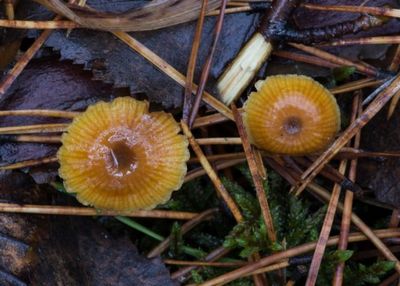
This specimen is a fruiting body with a pronounced cap and a thin stem. The size of the cap in diameter can vary from 0.5 to 3 cm. At a young age, it has a convex shape, after which it becomes prostrate or widely raised with a smaller tubercle in the very center and wavy edges. The surface is smooth, after the rain has passed, it becomes sticky. The color of the cap can be brown or reddish with a dark brown spot in the very center. The plates of the stem-shaped xeromphalin are rare and translucent, in young specimens they are pale yellow or cream, and in older ones they are yellow or yellowish-ocher.
The leg of this species is hollow and thin, its thickness is only 1-2 mm, and the length can vary from 3 to 8 cm. Downwards it becomes significantly wider, approximately up to five centimeters. The color is yellowish or yellow-red on top with a smooth transition from brown to black. Elliptical spores, uncolored. The pulp is brittle and thin, yellowish in color.
Where do stem-shaped xeromphalins grow?
A good time for the development of xeromphaline stem is at the end of August. In the absence of frost, it grows until a prolonged autumn. Prefers coniferous and mixed forests, grows in strong accumulations on coniferous litter and also among mosses, cones and pine needles.
Is it possible to have stem-shaped xeromphalins
This specimen is not classified as toxic mushrooms. However, most reference books say that stem-shaped xeromphaline does not represent nutritional value if from this it is considered inedible.
How to distinguish stem-shaped xeromphalins
It should be noted that some varieties of mushrooms of the genus Xeromphalin are similar to each other. an excellent example is the variety called bell-shaped, with a drawing of which can be found below.
In many cases, they all grow in groups, are smaller and similar in color.
To distinguish the species in question from the rest, you need to turn your attention to a more convex cap and a very thin leg. But, when collecting these mushrooms, you need to be careful, because the two options are inedible.
Conclusion
Xeromphaline stem-shaped is found very often not only in our country, but in fact all over the world. However, it frankly does not enjoy popularity, because it is not considered suitable for consumption.
How to prepare and store a fern
Bracken is an edible fern. In Russia, it is little used, dishes from this plant are considered exotic. In the world, especially in Japan, such an unusual cuisine for Europeans is very developed, the Orlyak pagon snack is a fairly popular and familiar dish.
The shoots of a young fern - rachis are used for food.They appear in early May and resemble a snail in their appearance - the top of the petioles is wrapped in a spiral. Shoots are harvested before the first leaves appear - a mature plant becomes poisonous.
For cooking, use rachis no more than 30 cm, they are cut at a height of 5 cm from the ground. The sprouts are sorted by color and size, aligned along the top edge, tied, cut off exactly the bottom. You can keep the stems fresh for no more than 10 hours after harvesting; it is necessary to start harvesting rachis for the winter in 2-3 hours - this way the maximum number of useful things is preserved.
Attention! In no case should the shoots be eaten raw - they can cause serious harm to the body. Pagon salting is carried out for industrial production
At home, the fern is harvested by drying, freezing or pickling
Pagon salting is carried out for industrial production. At home, the fern is harvested by drying, freezing or pickling.
Fern drying
Drying the sprouts allows you to preserve the original taste of the plant. Dense and large shoots up to 20 cm long are selected, pre-blanched in salted water for several minutes, then transferred to a colander, washed with cold water - this helps to maintain the elasticity and juiciness of the fern.
It is very important not to overcook the rachis, otherwise they will become tasteless and stratified. When the shoots have cooled down, the remaining moisture will drain off, you can start drying
There are two ways to dry the resulting workpiece:
- Outdoors. The process is lengthy and rather painstaking. It is necessary to prepare a well-ventilated dry room, place the fern on paper or in a special mesh for drying vegetables. For 5-7 days, the sprouts periodically turn over, knead slightly.
- In an electric dryer. Express procurement method. Prepared shoots are placed in an electric dryer in a thin layer and dried at a temperature of 50 degrees for about 6 hours. You should be careful - the drying time largely depends on the size of the pagons. It is better not to dry them slightly than to dry them out and lose the results of labor.
Dried pagons are placed in fabric bags, which are hung and remain in the fresh air for another couple of days to dry at natural temperature and humidity.
Advice. The quality of the product can be determined by the appearance of the rachis - properly dried pagons retain their characteristic aroma, plasticity, acquire a rich green or brownish-green color. If the shoots break, they may be overdried.
A very important nuance in the preparation is how to store the dried fern. Shoots are placed in paper or cloth bags and left in a dark, dry room. In case of high humidity, it is better to transfer the pagons into a glass container that closes tightly. In this state, the product retains its qualities for two years.
Freezing fern
A simple and effective method to prepare shoots that practically do not differ in appearance and taste from a fresh product is to freeze ferns:
- sprouts are selected, washed, cut into convenient pieces.
- blanched in salt water, reclined in a colander, washed with ice water.
- after the liquid is removed from the glass shoots, they are dried on a towel or paper, and cooled.
- ready-made rachises are transferred to food zipp-bags or plastic containers, placed in the freezer.
Another interesting way to prepare Orlyak is to marinate. To do this, boiled salted sprouts are laid out in jars and poured with marinade with soy sauce, apple cider vinegar, garlic, sugar and salt.
The result is a delicious snack reminiscent of pickled mushrooms.
Cooking edible fern
Bracken is a healthy and tasty plant that is widely used in oriental cuisine. It can be used to prepare salads, soups, snacks, stews and fried dishes.Shoots of young fern go well with rice, noodles, vegetables, meat and seafood. Bracken has a positive effect on the digestion process, is rich in vitamins, besides, its calorie content is quite low - 34 kcal.
Interesting! Fried fern is especially popular - this method of preparation helps to preserve the taste and crispness of the shoot.
Roasted fern recipes
In almost all recipes, you can cook fresh, frozen, dried and salted ferns. You just need to take into account some of the nuances: it is recommended to soak dried pagons in warm water for several hours, salted ones - it is necessary to rinse thoroughly.
With onion
Cut 2 medium onions into half rings, fry in vegetable oil until golden brown, add 500 g of boiled fern cut into small pieces to a frying pan, fry for a few minutes. This is a simple yet delicious dish. If desired, you can add carrots, season with sour cream and mayonnaise. Seasoned with soy sauce for a Korean-style fern.
Fern dishes
With potato
300 g of boiled sprouts must be fried until crispy, put on a plate. Put 500 grams of potatoes, cut into long pieces, in a frying pan, fry until tender. Season with salt, pepper, add prepared fern. If desired, you can add onions, garlic. The potato takes on a delicious mushroom flavor.
With meat
The meat is cut into thin slices, marinated with salt, pepper, soy sauce. Onions are cut in half rings, fried in vegetable oil, put on a plate. The meat is laid out in a frying pan, fried until golden brown, and brought to half-readiness.
Prepared shoots are placed on the meat, onions are added. If you wish, you can put out the dish with sour cream or soy sauce, add sesame seeds.
If the fern is bitter
In the process of cooking rachis, you can face a common problem - the fern tastes bitter, radically changing the taste of the dish. How easy is it to remove bitterness from a fern? It's very simple: soak the shoots for several hours in salted water, change the water a couple of times.
Then rinse the pagons well and boil them for 6-9 minutes with the addition of salt. Such sprouts are ready for consumption or further harvesting and storage.
The bracken fern is not only a beautiful plant. It can be grown at home, used to decorate an alpine slide or a corner in the garden. In addition, the culture is valued for its beneficial properties and is used in medicine. Bracken is an edible fern, delicious dishes are prepared from it, fried, pickled, harvested for the winter.
What are the signs to distinguish edible from poisonous ryadovka?
Last year I collected rows in our forest (they are gray, but not quite the same as the “gray rows” in the photo in reference books). This year I also collected them. And he ate without any problems. And then suddenly I decided to look about them on the Internet. And I found an article where the photo is “my row”, and they write that the mushroom is poisonous.
P.S. * I got the impression that the photos were mixed up on the Internet. Since I am writing this question to you after I ate a frying pan of these mushrooms :) But the question: how to distinguish them, I still have. *.
P.P.S. Additional signs: the flesh is white, often wormy. There are no scales on the cap. After boiling, a slight specific smell remains. It looks like white or earthy rows. When fried, it’s nothing.
In general, the question is very useful, because there are disputes about mushrooms (not only about rowers). And in some sources some kind of mushroom belongs to edible, in others it is considered conditionally edible, and in others it is even called poisonous. Therefore, experienced mushroom pickers rely solely on their own experience. But novice mushroom pickers still need to carefully study this issue.
As for the ryadovka, there are a lot of varieties of this mushroom with very different, even exotic names (tiger ryadovka). It seems to me that you just need to remember which rows are NOT edible, because there are fewer of them.White, brindle (leopard) and brown ryadovka are considered poisonous.
It seems to me that “your” rowing should be differentiated from the white rowing. “Yours” sounds like a gray row or earthy, don't you think?
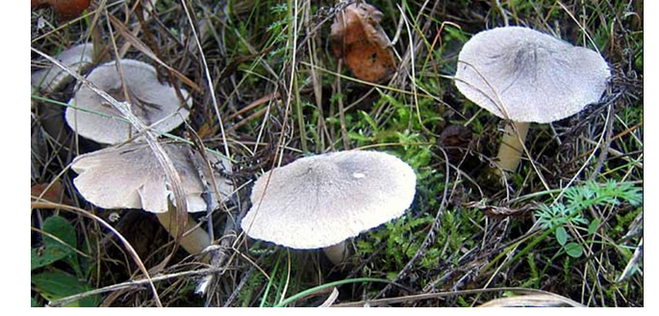
This is an earthy row.
“Your” has no scales on the cap, while the white one has a lot of them.
At the white ryadovka, the leg seems to be showered with flour, it has such a bloom.
The white ryadovka is described either in silver color, then with a blue tint, then with brown spots on the cap, then with a yellow tubercle in the center - so go and figure it out).
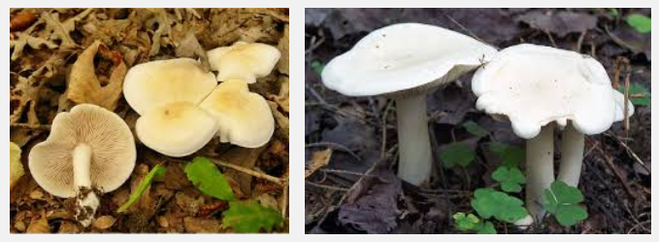
In these photographs, both the one and the other mushroom are described as "ryadovka white". But they are very different!
But the smell is pleasant in a gray and earthy row, and in a white one, over time, the smell resembles the smell of a radish, musty and unpleasant. Therefore, I would let the mushrooms lie down and then, by the smell, I would determine whether this ryadovka is good or not.
And it is difficult to navigate by photographs and descriptions.
Xeromphaline bell-shaped: description and photo
| Name: | Xeromphaline bell-shaped |
| Latin name: | Xeromphalina campanella |
| Type of: | Inedible |
| Synonyms: | Omphalina bell-shaped, Omphalina campanella |
| Specifications: |
|
| Systematics: |
|
Xeromphalina campanella or omphalina campanulate is a mushroom that belongs to the numerous genus Xeromphalina, the Mycene family. It has a hymenophore with rudimentary plates.
What do bell-shaped xeromphalins look like?
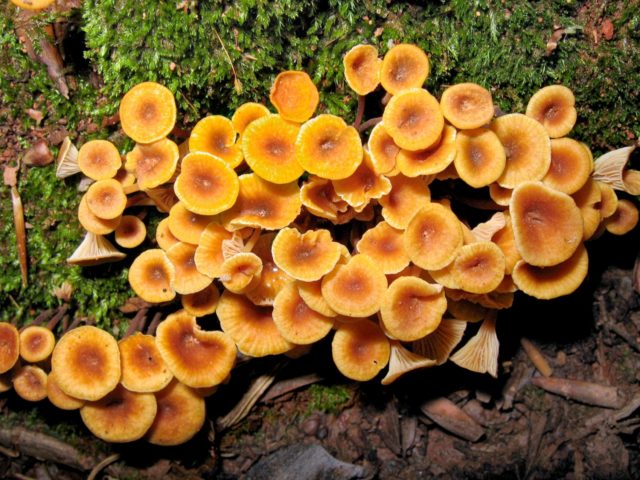
This mushroom is very small. The size of its cap is similar to 1–2 kopeck coins, and does not exceed 2 cm in diameter. The color of the bell-shaped xeromphaline is orange or yellowish-brown.
The hat has a rounded convex shape with a characteristic depression in the center, and is translucent at the edges. In older specimens, it can fully straighten or even curl upward. Rare plates descend along the pedicle; they are yellowish-orange or cream colored. On closer inspection, you can see the transverse veins connecting the plates to each other. The surface of the cap is smooth, shiny, radially striped due to the plates translucent from below, in the center its color is more saturated - dark brown, at the edges - lighter.
A very thin fibrous stem is 0.1-0.2 cm thick and 1 to 3 cm high. In the upper part it is colored yellow, and in the lower part it is orange-brown with fine white pubescence along the entire length. The leg has a cylindrical shape, slightly widened at the top, with a noticeable thickening at the base. The flesh of the mushroom is thin, reddish-yellow, without a pronounced odor.
Where do bell-shaped xeromphalins grow
They grow on decaying wood, most often pine or spruce. In the forest, they are found in numerous colonies. These mushrooms are typical for a natural zone with a temperate continental climate, where the average air temperature in July does not exceed 18 ° C, and the winters are severe and cold. The coniferous forests of these latitudes are called taiga. Bright orange caps are easy to spot on stumps in May. The fruiting season lasts from late spring to the end of autumn.
Is it possible to eat bell-shaped xeromphalin
Nothing is known about the edibility of the mushroom. Research in the laboratory has not been carried out, and experts do not advise trying to taste unfamiliar representatives of the mushroom kingdom, very similar to the deadly poisonous gallerinas. Due to its small size, the mushroom cannot be of nutritional value.
How to distinguish bell-shaped xeromphalins
The genus Xeromphalin has 30 species, of which only three are found in Western Siberia - K. bell-shaped, K. stalk-shaped, and K. Cornu. It is rather difficult to distinguish these mushrooms, the most reliable way is microscopic examination.
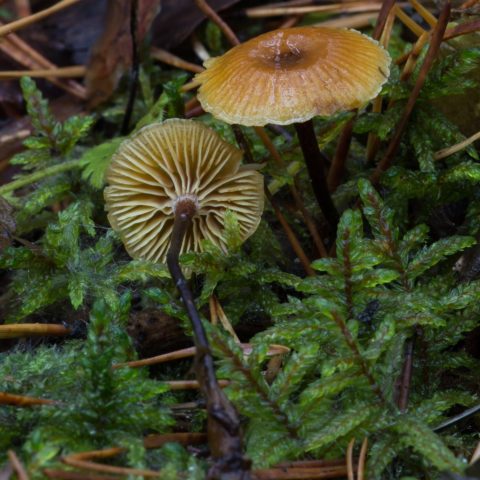

Xeromphaline bell-shaped differs from the other two representatives of its genus, growing on the territory of Russia, in earlier and longer fruiting. The other two species appear only in the middle of summer. These mushrooms also have no nutritional value due to their small size, they are inedible.
An inexperienced mushroom picker may confuse the bell-shaped xeromphaline with the deadly poisonous gallery bordered. However, the latter is slightly larger in size, its cap does not have a depression in the middle and transparency, due to which the lamellar hymenophore is well visible.
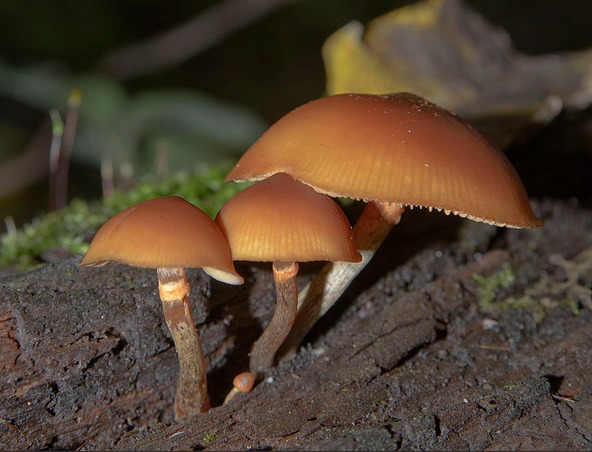
Conclusion
Xeromphaline campanulate grows in coniferous forests from May to November. Most often, the mushroom can be found in the spring, the first wave of fruiting is the most abundant. This species does not represent nutritional value due to its tiny size, and nothing is known about its toxicity.
Definitioner
- Basidia (Basidia)
-
Lat. Basidia. A specialized structure of sexual reproduction in fungi, inherent only in Basidiomycetes. Basidia are terminal (end) elements of hyphae of various shapes and sizes, on which spores develop exogenously (outside).
Basidia are diverse in structure and method of attachment to hyphae.
According to the position relative to the axis of the hypha, to which they are attached, three types of basidia are distinguished:
Apical basidia are formed from the terminal cell of the hypha and are located parallel to its axis.
Pleurobasidia are formed from lateral processes and are located perpendicular to the axis of the hypha, which continues to grow and can form new processes with basidia.
Subasidia are formed from a lateral process, turned perpendicular to the axis of the hypha, which, after the formation of one basidium, stops its growth.
Based on morphology:
Holobasidia - unicellular basidia, not divided by septa (see Fig. A, D.).
Phragmobasidia are divided by transverse or vertical septa, usually into four cells (see Fig. B, C).
By type of development:
Heterobasidia consists of two parts - hypobasidia and epibasidia developing from it, with or without partitions (see Fig. C, B) (see Fig. D).
Homobasidia is not divided into hypo- and epibasidia and in all cases is considered holobasidia (Fig. A).
Basidia is the place of karyogamy, meiosis and the formation of basidiospores. Homobasidia, as a rule, is not functionally divided, and meiosis follows karyogamy in it. However, basidia can be divided into probasidia - the site of karyogamy and metabasidia - the site of meiosis. Probasidium is often a dormant spore, for example in rust fungi. In such cases, probazidia grows with metabasidia, in which meiosis occurs and on which basidiospores are formed (see Fig. E).
See Karyogamy, Meiosis, Gifa.
- Pileipellis
-
Lat. Pileipellis, skin - differentiated surface layer of the cap of agaricoid basidiomycetes. The structure of the skin in most cases differs from the inner flesh of the cap and may have a different structure. The structural features of pileipellis are often used as diagnostic features in descriptions of fungi species.
According to their structure, they are divided into four main types: cutis, trichoderma, hymeniderma and epithelium.
See Agaricoid fungi, Basidiomycete, Cutis, Trichoderma, Gimeniderm, Epithelium.
- Cutis
-
The type of cap skin, consists of creeping non-gelatinized hyphae located parallel to the surface. The surface of the cap looks smooth.
Lat. Cutis.
See Gifa.
- Anastomoses (Anastomosis)
-
1) Fusion of cells of branched hyphae or germ tubes of germinating spores;
2) Connecting the plates of the fruiting bodies of the mushrooms with jumpers.
- Amyloid (Amyloid structure)
-
The structure is called amyloid if from Melzer's reagent (solution of 0.5 g of crystalline iodine + 1.5 g of potassium iodide + 20 ml of chloral hydrate + 20 ml of distilled water) turns blue, violet, sometimes almost black.
See Dextrinoid structure.

